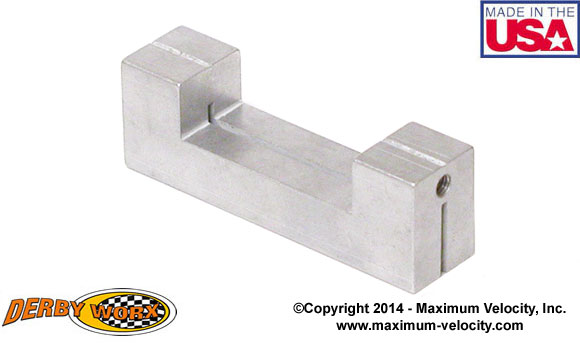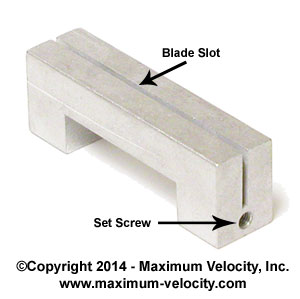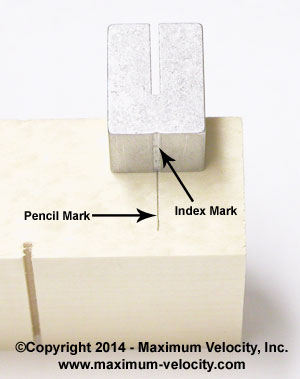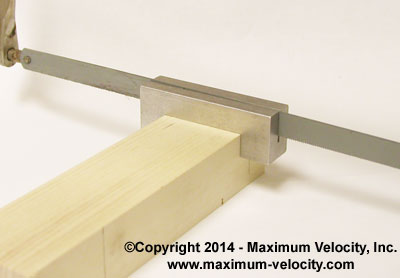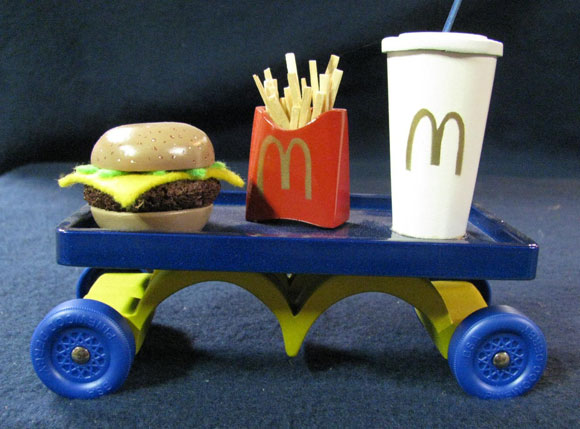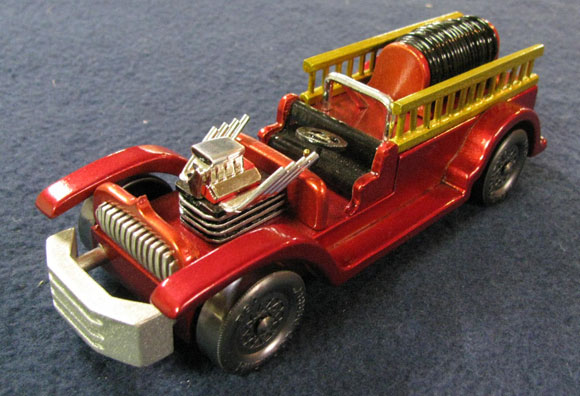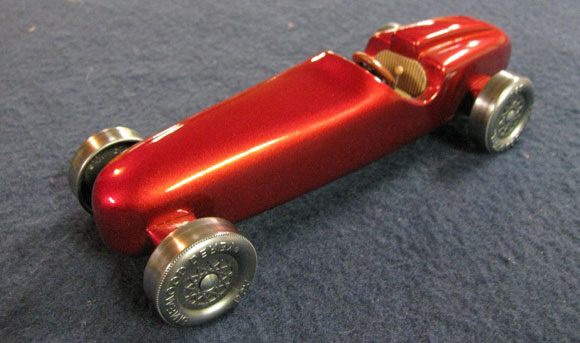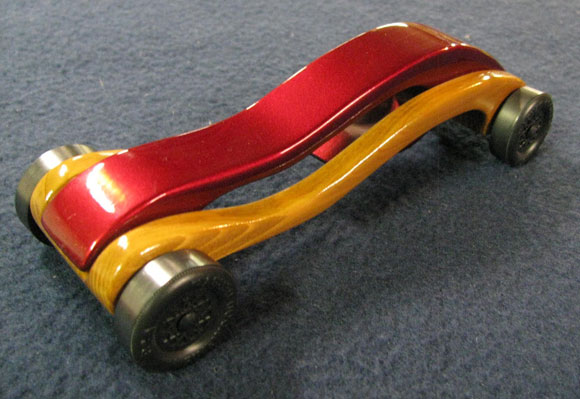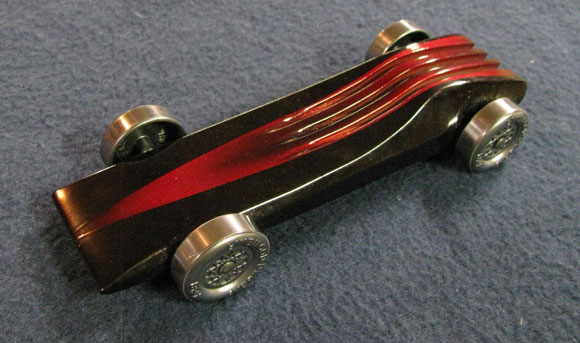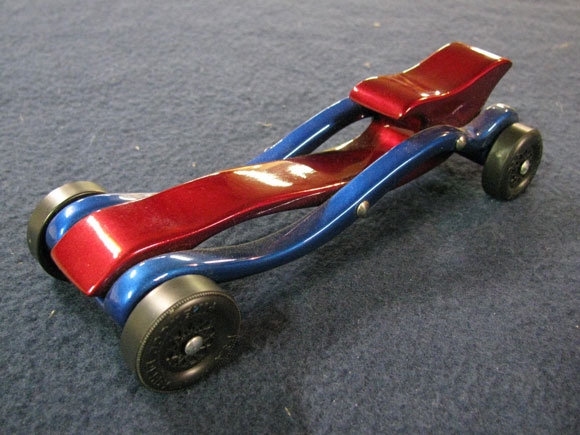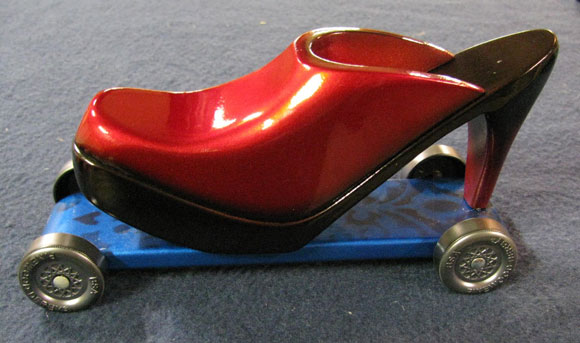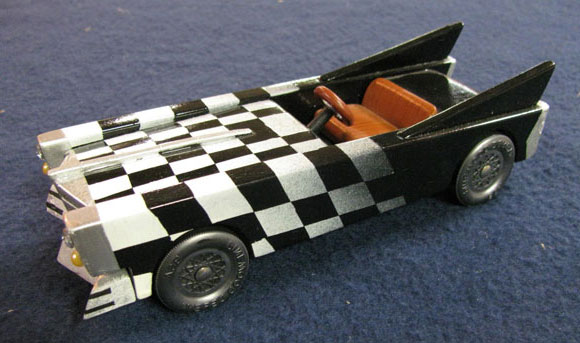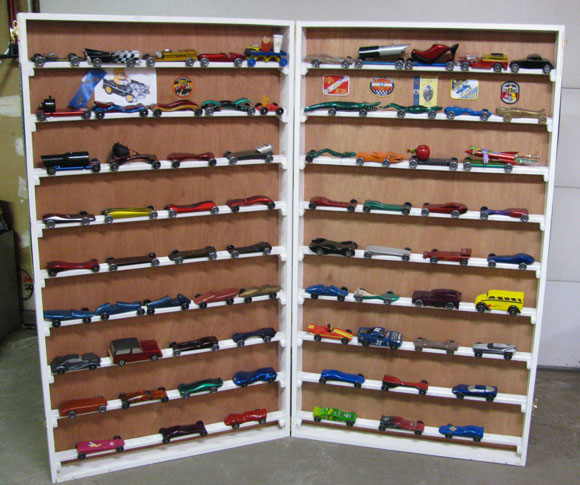– Feature Article – Creating Accurate Axle Slots
– Humor
– Pinewood Derby Car Showcase
– Q&A
Creating Accurate Axle Slots
By Randy Davis
Most brands of pinewood derby kits come with slots on one side of the block into which the axles are pressed. These pre-made slots generally work well, but there are occasions when the car builder would like to cut new axle slots. These include when:
- The existing slots are defective.
- The builder wishes to change the wheelbase by cutting new slots on the opposite side of the block.
- The builder wishes to build two cars from one block by cutting new slots on the opposite side of the block.
Previously, cutting new slots was a bit tricky. Usually, a hacksaw was equipped with two blades, and then the builder carefully cut new slots by following a pencil line. Obviously, errors were common: cutting a slanted line or cutting too deep were common issues.
But now, a new tool is available to solve these issues and greatly simplify the process of cutting new slots.
Pro-Body Slotter From Derbyworx
DerbyWorx recently introduced the Pro-Body Slotter. Similar to the Pro-Body Tool for drilling accurate axle holes, the Pro-Body Slotter is a cutting guide for cutting axle slots.
Figure 1 – Pro-Body Slotter
The tool fits over a standard pinewood derby block, and is held in place with a set screw (a clamp would interfere with sawing). Index marks on the tool are aligned with a pencil mark on the block which identifies the desired location of the new slot.
Figure 2 – Pro-Body Slotter Parts
Figure 3 – Pro-Body Index Marks
As mentioned before, two hacksaw blades are mounted on a hacksaw frame (one blade is mounted with the teeth forward and the other with the teeth reversed. The blades are then placed into the slot in the tool, and the cut is made.
After the first cut is complete, the tool is loosened, moved to the next slot position, reattached, and then the second cut is made.
Figure 4 – Pro-Body Slotter in UseThe index screw will leave two indents in the block, one per slot. These marks are filled with wood filler before sanding and painting. Note that the marks will be located behind the wheels, so they are not obvious.
Tips
Here are a few tips for using the Pro-Body Slotter.
- Use the Pro-Body Slotter on the pinewood derby block before cutting or shaping the block.
- When placing the tool onto the block, orient the set screw on the side of the block opposite the pencil marks.
- Keep the set screw on the same side of the block for both cuts.
- Use even, gentle forward and back sawing strokes.
- Make sure to stop when the saw blades reach the bottom of the tool.
- For an extended wheelbase, position the slots at 5/8 inch (actually I prefer 11/16 inch) from each end of the block.
- After cutting the slots, use a Pro-Axle Guide to insert a spare axle into each slot position, then twist and pull it out with a pair of pliers.
- When painting, either mask off the axle slots, insert a spare set of axles into the axle slots, or better yet, use a Paint Stand.
Conclusion
Using the Pro-Body Slotter makes creating accurate axle slots a simple process. The Pro-Body Slotter is available from many on-line vendors including Maximum Velocity. A video from DerbyWorx on using the Pro-Body Slotter is available Here.
Humor
A man walks into a health-food restaurant after a day at the office, sits down, and orders a nice big dish of brown rice and stir-fry veggies.
He grabs a handful of peanuts from the bowl on the counter by the cash register while he’s waiting for his order, and as he starts to chew he hears a voice say, “That’s a beautiful tie. Is that silk? Very nice choice!”
Wondering who would make such a strange comment, he looks around and doesn’t see anyone near him who could’ve been speaking to him. With a shrug, he pops a few more peanuts into his mouth.
Next he hears a voice, “Those shoes are stylin’, my man. Are they Italian leather? They look GRRREAT!”
He whirls around again but sees no one near him. He glances nervously around and then at his shoes, which he tucks self-consciously under the stool.
A little weirded out, he grabs another handful of peanuts. This time the voice continues with, “That suit looks FANTASTIC! Is it an Armani? Very nice!”
He immediately calls the waiter over and says, “Look. I keep hearing these voices telling me how great my tie, my shoes, and my suit look. What’s up with that? Am I going crazy?”
“Oh,” the waiter nonchalantly replies, “those are just the peanuts.”
“The PEANUTS?” the astonished man asks, staring at the bowl beside him.
“Yes,” replies the waiter, “they’re complimentary!”
Pinewood Derby Car Showcase
Today’s cars are owned by Darren Stark.
“I started a collection of pinewood derby cars and now have close to eighty. Sixty-five to seventy of them I personally built with family and friends. The photos below show a few of my favorites.
My son and I go to several races every year and display our cars with Todd Paxson. Todd is a friend of mine who’s cars were used to make the movie “Down and Derby”. He is the one who convinced me to display my cars rather than keep them in a box. My son and I get such a kick out of watching people’s reactions to our cars and helping others figure out how they can make their ideas come to life. I hope you like them as much as we do
Editor’s Note: Todd Paxson’s display was featured in Volume 6, Issue 14.
Q&A
We had a pinewood derby race last night and the results contradicted everything I have learned, and the racing experts teach, on how to build a winning car. I am wondering what your thoughts are.
The winning car was an uncut block of wood from a Cub Scout Pinewood Derby kit. The axles were untreated – no filing of burrs, no sanding, no polishing. Nothing was done to the wheels. The center of gravity was in the middle of the car. They took their kit the day before the race, just attached the wheels, and applied graphite to the wheels just before the race.
The car competed in a field of about 15. It beat cars of several competitors who do the standard practices of filing/polishing axles, drill holes for axles, polish wheels, set the center of gravity towards the rear axle, etc. Every kid started with the same kit.
Well there are two possibilities:
- The car looked like a dud but was really a ringer – block hollowed out and back-weighted. Prepped wheels/axles, etc. You would need to inspect the car (check balance point, check wheels, etc.) to know for sure.
- The car was a fluke. There are cases were a car makes it down the track without touching a guide rail. When that happens, it really speeds up the run.
Does your track have a continuous slope from start to finish, or is it the more typical ramp, followed by a long flat section. If a continuous slope track, then flukes are more likely to occur. They don’t happen often on a ramp-flat track.
How much does temperature and humidity effect the speed of pinewood derby cars? We are in the Northeast (New York), and outside conditions significantly affect the temperature and humidity levels inside the buildings during this time of year. The cars were all off in speed again this year. Last year the cars were the fastest ever in the six years that we have been participating. The same Scouts were still fast as in previous years. There seems to be too many variables that significantly control the speed of these cars.
There are certainly a lot of variables involved in pinewood derby racing.
Temperature affects liquid lubes (cold is bad), while the lack of humidity affects graphite adversely. Graphite needs a little humidity to work well. So if the heating is cranked in the building, everything gets dry and graphite-lubed cars lose performance.
However, a big factor that affects races from year to year is the track setup. If the track is very level one year, and then not level the next, times will be affected. This can happen due to moving the location of the track or from careless setup.
Want Answers?
Do you have a pinewood derby-related question? If so, e-mail us your question.We answer all questions by e-mail, but not every question will appear in the Q&A section of the newsletter.
Back Issues
Are you a new subscriber, or have you missed some of the previous newsletters? Don’t miss out; all of the issues for Volume 5 through Volume 17 are posted on our web site.
Newsletter Contributions
We welcome your contributions. If you would like to contribute an article, a web site review, a speed tip, or a pinewood derby memory, please e-mail us.
Subscription Information
The Pinewood Derby Times is a free e-newsletter focused on pinewood derby racing. It is published biweekly from October through March.
If you haven’t already done so, please forward this issue to your pinewood derby friends. But please don’t subscribe your friends. Let them decide for themselves. Thanks.
If this newsletter was forwarded to you, why not subscribe to receive this newsletter. There is no cost, and your e-mail address is safe, as we never sell or share our distribution list.
To subscribe, send a blank e-mail to
pi*********************@*******st.com
You will receive a confirmation e-mail. Reply to the confirmation e-mail and you will start receiving the Pinewood Derby Times with the next issue.
Randy Davis, Editor, Pinewood Derby Times
E-Mail: in**@**************ty.com
(C)2018, Maximum Velocity, Inc. All rights reserved. Please do not reprint or place this newsletter on your web site without explicit permission. However, if you like this newsletter we grant permission, and encourage you to e-mail it to a friend.
Maximum Velocity disclaims any personal loss or liability caused by utilization of any information presented in this newsletter.
The Pinewood Derby Times is not specific to, and is not affiliated with the Boy Scouts of America, YMCA, Awana, or any other organization.
(R)Maximum Velocity is a registered trademark of Maximum Velocity, Inc.
(R)Pinewood Derby is a registered trademarks of the Boys Scouts of America.
(R)Awana is a registered trademark of Awana Clubs International.
All other names are trademarks of their respective owners.

